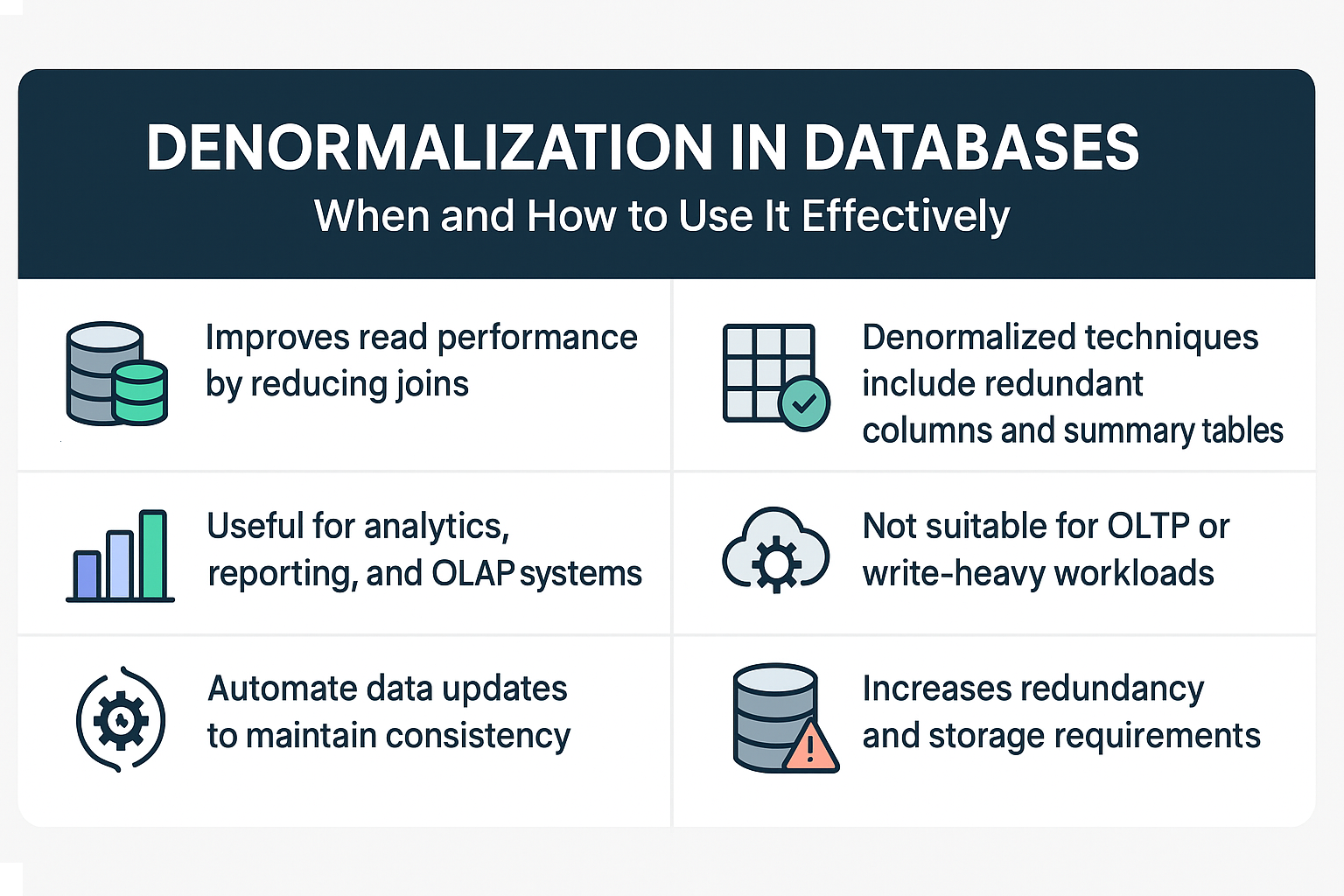Introduction
Denormalization is the process of intentionally introducing redundancy into a database to improve read performance and reduce query complexity. It’s often used in reporting, analytics, and high-performance systems.
Why Denormalization Matters
- Speeds up complex queries by reducing joins.
- Optimizes read-heavy systems like dashboards and analytics.
- Helps in building scalable systems where performance is critical.
Real-world analogy:
Think of denormalization like a prepared meal. Instead of cooking each ingredient every time (joining normalized tables), you keep a ready-made dish for quick serving.
Core Concepts
What is Denormalization?
- The reverse of normalization: merging tables or duplicating data for faster access.
- Used strategically to balance performance and data integrity.
Key Techniques
- Adding redundant columns.
- Precomputing aggregates.
- Creating summary tables.
- Combining frequently joined tables.
SQL Examples
Normalized Design
Orders Table:
| order_id | customer_id | amount |
|---|---|---|
| 1 | 101 | 500 |
Customers Table:
| customer_id | name |
|---|---|
| 101 | Alice |
Denormalized Design
| order_id | customer_id | customer_name | amount |
|---|---|---|---|
| 1 | 101 | Alice | 500 |
Summary Table Example
CREATE TABLE sales_summary AS
SELECT customer_id, SUM(amount) AS total_spent
FROM orders
GROUP BY customer_id;
Real-World Use Cases
- Analytics Dashboards: Pre-aggregated data for instant reports.
- E-commerce: Denormalized product and category data for fast catalog loading.
- Data Warehouses: Optimizing read-heavy OLAP queries.
Common Mistakes and Anti-Patterns
- Over-denormalizing: Leads to excessive storage and maintenance issues.
- Not updating redundant data consistently: Causes data integrity problems.
- Using denormalization for all tables: It’s not a replacement for normalization.
Performance and Scalability Implications
- Benefits: Faster reads, reduced join complexity, better analytics performance.
- Drawbacks: Increased storage, potential for data inconsistency, more complex writes.
RDBMS Comparison
| Feature | PostgreSQL | MySQL | Oracle |
|---|---|---|---|
| Materialized Views | Supported | Partial (via tables) | Supported |
| Indexed Views | Partial Support | Supported | Supported |
| JSON/Denormalized Data | Strong Support | Strong Support | Strong Support |
Best Practices & Optimization Tips
- Use denormalization only after identifying performance bottlenecks.
- Automate redundant data updates via triggers or application logic.
- Use materialized views for precomputed aggregates.
- Document denormalized structures for maintainability.
When to Use vs When to Avoid
Use Denormalization When:
- Read performance is critical.
- Joins cause significant latency.
- Building reporting or OLAP systems.
Avoid Denormalization When:
- OLTP systems require strict consistency.
- Write-heavy workloads where maintaining redundancy is costly.
Conclusion & Key Takeaways
Denormalization is a performance tuning strategy, not a design default. Used wisely, it balances speed and complexity in high-performance database systems.
Key Points:
- Denormalization improves read performance at the cost of redundancy.
- Ideal for OLAP and analytics-heavy workloads.
- Requires careful planning to maintain data integrity.
FAQ
1. What is denormalization in databases?
The process of adding redundancy to improve query performance.
2. How is denormalization different from normalization?
Normalization reduces redundancy; denormalization introduces it for performance.
3. Is denormalization always needed?
No, it’s a performance optimization, not a design rule.
4. Does denormalization improve write performance?
No, it usually makes writes more complex.
5. When should I denormalize?
When joins impact performance and read speed is critical.
6. What are common denormalization techniques?
Redundant columns, summary tables, precomputed aggregates.
7. Are materialized views a form of denormalization?
Yes, they store query results for faster access.
8. Does denormalization hurt data integrity?
If not managed carefully, it can lead to inconsistencies.
9. Which databases support denormalization?
All RDBMS can implement denormalization with tables or views.
10. Can I mix normalization and denormalization?
Yes, hybrid approaches are common in complex systems.
